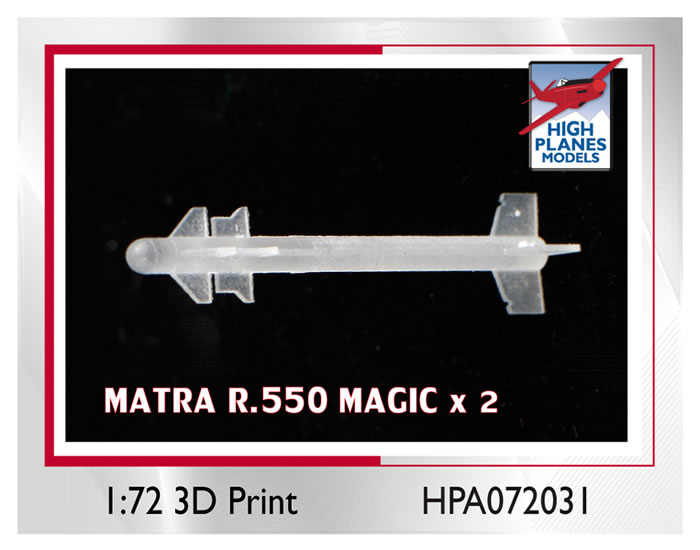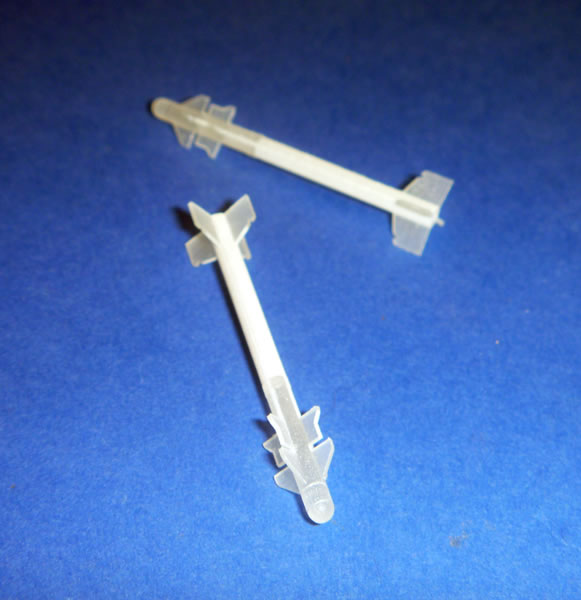|
Matra R.550 Magic

High Planes Models, 1/72 scale
S u m m a r y : |
Catalogue Number: |
High Planes Models Kit No. HPA072031 - Matra R.550 Magic |
Scale: |
1/72 |
Contents & Media |
Two resin missiles rendered by 3-D printer. |
Price: |
Available on-line from:
And from stockists worldwide.
Click here for currency conversion. |
Review Type: |
First Look. |
Advantages: |
Really nice scale finesse and no assembly required. |
Disadvantages: |
No painting guide (fairly easy to overcome however). |
Conclusions: |
These are the best after-market missiles of any kind I have encountered so far. This is due to their finesse and completeness, with no assembly required. A painting guide would have made for a more complete package, but the absence of such matters little.
I recommend this missile set most highly. |
Reviewed
by Mark Davies

cyber-hobby's 1/72 scale Sea Venom is available online from Squadron.com
The R.550 Magic is a short-range air-to-air missile designed in 1968 by French company Matra to compete with the American AIM-9 Sidewinder. On 11 January 1972, a Gloster Meteor of the centre for in-flight trials fired the R550 Magic and shot down a Nord CT20 target drone.
Mass-produced from 1976, the Magic was adopted by the French Air Force and the Navy.
The Argentine Air Force received "Magic 1" for its Mirage IIIEA during the 1982 Falklands War.
The Argentine Navy received "Magic 1" for its Super Etendards. However, they were procured after the 1982 Falklands War.
An upgraded version, the "Magic 2", replaced the original model in 1986. Now obsolete, 11,300 Magic 2 were produced and it was exported; notably to Iraq and Greece, who have used it in actual combat.
The Magic has 8 fixed fins, and 4 movable fins. It has a solid-fuel engine, and can engage the target independently from the firing aircraft with its passive Infra-red guidance system. The Magic 2 replaced the AD3601 seeking head by the AD3633, allowing frontal fire on the target (the Magic 1 could only be fired from the rear on the target). The Magic 1 has a transparent dome on its nose, while the Magic 2 is opaque.
The Magic is still carried by the Dassault Rafale, Dassault Mirage 2000, F-16, Sea Harrier (FRS51), Super Etendard, Mirage F1, Mirage 5, and Mirage III. It is gradually being replaced by the MBDA MICA.
Some 480 were sold to Taiwan and used by the Republic of China Air Force.
Source: Wikipedia.org.
Previous 1/72 Scale Matra Magic Missiles
I am aware of the R.550 being included in 1/72-scale weapon sets from Italeri, Airfix and Heller. I have read that Heller’s are the best, in part because of their PE fins, whilst Italeri’s were of indifferent quality. It is possible that the Heller and Airfix sets have the same contents from when both brands were owned by Humbrol. I have also read that possibly the best R.550 included with a kit are those found in Academy’s French F-8 Crusader boxing.
The Airfix and Heller weapons sets are rarities now, so the release of some modern after-market Matra Magics by High Planes is most welcome.
The two missiles come in clear plastic blister pack, and are further enclosed in a zip-lock plastic bag.

Each missile is made as one piece and has very delicate fins; every bit as fine would be PE parts, but without any of the hassle of having to fit 12 fiddly little parts spaced and aligned precisely on a resin missile body. No painting guide is provided, perhaps this is because there are too many variations between customer air forces? However, there are plenty of photos of the real thing to be found on the Internet.

It is quite common for accessory parts to be mastered using CAD and 3-D printers to produce a master from which a silicon mould for casting resin is produced. However, these missiles are produced directly by a 3-D printer. I first noticed their surface appearance under magnification, and clear nose sections integral with a solid fusleage (which allow a Magic 1 to be modeled). Then I saw it mentioned on HPM’s website (Doh!). It explains how such delicate fins can be produced without risk of damage, as would be the case with resin when being removed from a silicon rubber mould.
These are the best after-market missiles of any kind I have encountered so far. This is due to their finesse and completeness, with no assembly required. A painting guide would have made for a more complete package, but the absence of such matters little.
I recommend this missile set most highly.
Thanks to HPM Hobbies for the review sampl
Text Copyright © 2014 by Mark Davies
This Page Created on 25 March, 2014
Last updated
25 March, 2014
Back to HyperScale
Main Page
Back to Reviews
Page
 |
